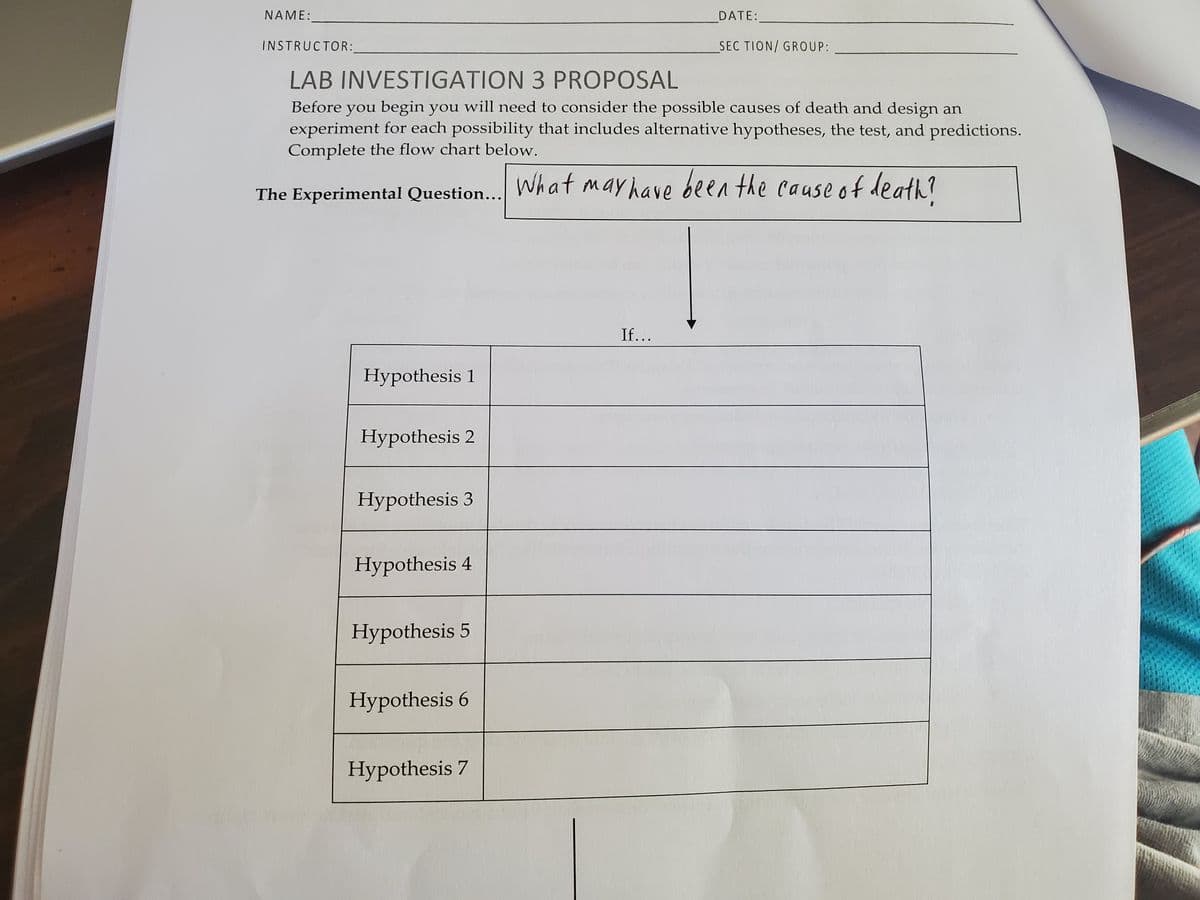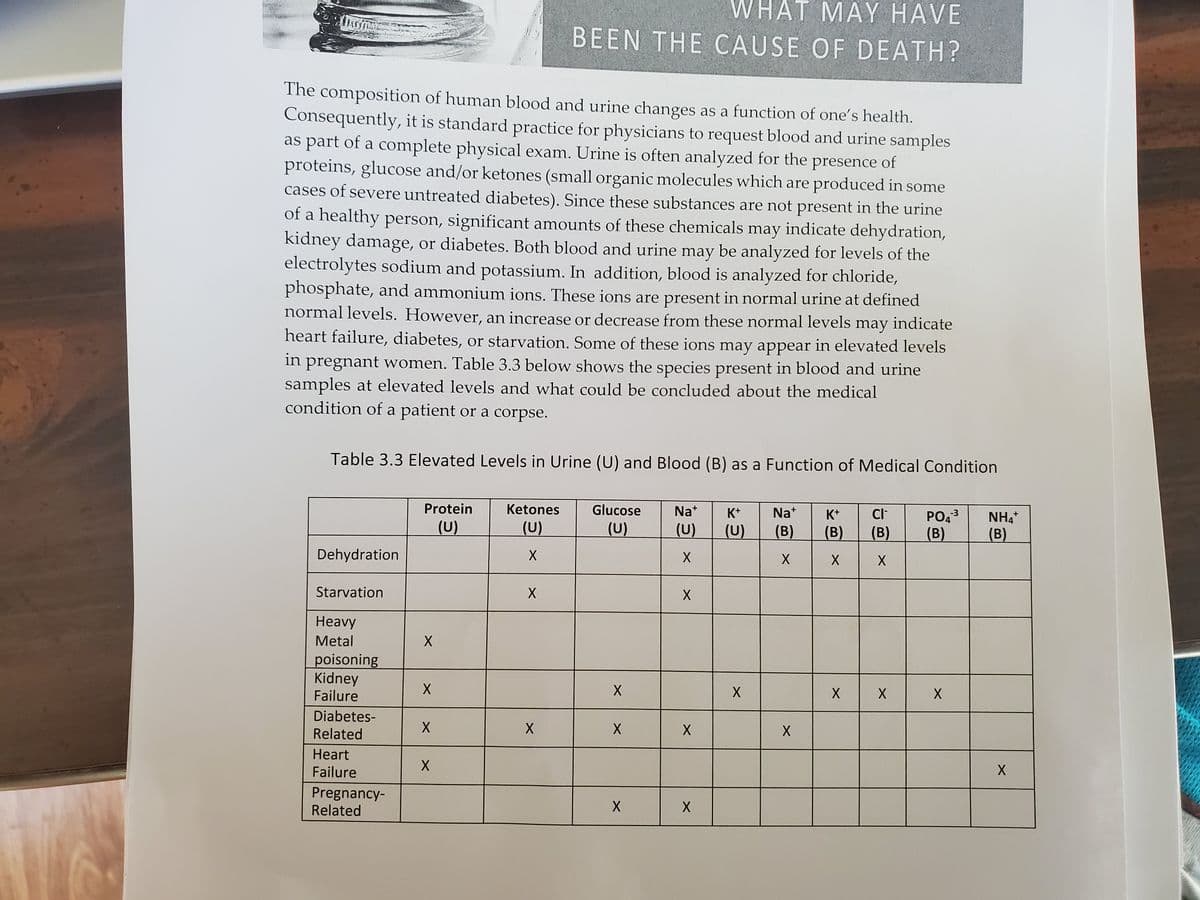Before you begin you will need to consider the possible causes of death and design an experiment for each possibility that includes alternative hypotheses, the test, and predictions. Complete the flow chart below. The Experimental Question... What may have been the cause of death? Hypothesis 1 Hypothesis 2 If...
Before you begin you will need to consider the possible causes of death and design an experiment for each possibility that includes alternative hypotheses, the test, and predictions. Complete the flow chart below. The Experimental Question... What may have been the cause of death? Hypothesis 1 Hypothesis 2 If...
Linear Algebra: A Modern Introduction
4th Edition
ISBN:9781285463247
Author:David Poole
Publisher:David Poole
Chapter4: Eigenvalues And Eigenvectors
Section4.6: Applications And The Perron-frobenius Theorem
Problem 22EQ
Related questions
Question

Transcribed Image Text:NAME:
Hypothesis 1
INSTRUCTOR:
LAB INVESTIGATION 3 PROPOSAL
Before you begin you will need to consider the possible causes of death and design an
experiment for each possibility that includes alternative hypotheses, the test, and predictions.
Complete the flow chart below.
The Experimental Question... What may have been the cause of death?
Hypothesis 2
Hypothesis 3
Hypothesis 4
Hypothesis 5
Hypothesis 6
Hypothesis 7
DATE:
If...
SEC TION/ GROUP:

Transcribed Image Text:i
The composition of human blood and urine changes as a function of one's health.
Consequently, it is standard practice for physicians to request blood and urine samples
as part of a complete physical exam. Urine is often analyzed for the presence of
proteins, glucose and/or ketones (small organic molecules which are produced in some
cases of severe untreated diabetes). Since these substances are not present in the urine
of a healthy person, significant amounts of these chemicals may indicate dehydration,
kidney damage, or diabetes. Both blood and urine may be analyzed for levels of the
electrolytes sodium and potassium. In addition, blood is analyzed for chloride,
phosphate, and ammonium ions. These ions are present in normal urine at defined
normal levels. However, an increase or decrease from these normal levels may
indicate
heart failure, diabetes, or starvation. Some of these ions may appear in elevated levels
in pregnant women. Table 3.3 below shows the species present in blood and urine
samples at elevated levels and what could be concluded about the medical
condition of a patient or a corpse.
Table 3.3 Elevated Levels in Urine (U) and Blood (B) as a Function of Medical Condition
Dehydration
Starvation
Heavy
Metal
poisoning
Kidney
Failure
Diabetes-
Related
Heart
Failure
Pregnancy-
Related
Protein
(U)
X
X
X
X
Ketones
(U)
X
WHAT MAY HAVE
BEEN THE CAUSE OF DEATH?
X
X
Glucose
(U)
X
X
X
Nat K+
(U)
(U)
X
X
X
X
X
Na+ K+
(B)
X
CI
(B) (B)
X
X
X
X
X
PO4-3
(B)
X
NH4+
(B)
X
Expert Solution
This question has been solved!
Explore an expertly crafted, step-by-step solution for a thorough understanding of key concepts.
This is a popular solution!
Trending now
This is a popular solution!
Step by step
Solved in 3 steps

Recommended textbooks for you

Linear Algebra: A Modern Introduction
Algebra
ISBN:
9781285463247
Author:
David Poole
Publisher:
Cengage Learning


Linear Algebra: A Modern Introduction
Algebra
ISBN:
9781285463247
Author:
David Poole
Publisher:
Cengage Learning
